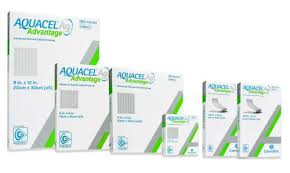
Understanding Aquacel AG: Properties, Benefits, and Applications
Introduction to Aquacel AG
Aquacel AG is a specialized wound dressing designed to promote effective healing in various types of wounds. Formulated with a unique combination of materials, this dressing primarily consists of cellulose fibers that have been processed to create a hydrophilic fabric. The addition of silver ions enhances its antimicrobial properties, making Aquacel AG particularly effective in managing infections and preventing biofilm formation at the wound site.
The distinctive properties of Aquacel AG contribute to its suitability in both chronic and acute wound care. Upon contact with exudate, the dressing transforms into a gel-like consistency, which not only maintains a moist environment but also facilitates autolytic debridement. This moist wound healing approach is essential for promoting optimal tissue regeneration while minimizing pain during dressing changes. Additionally, Aquacel AG is designed to conform to the wound, ensuring a secure fit that protects the area from external contaminants.
Moreover, Aquacel AG’s porous structure allows for vapor exchange, which is crucial for maintaining skin integrity and preventing maceration around the wound edges. This feature is particularly beneficial for patients dealing with non-healing ulcers or post-surgical wounds. Its ease of use, combined with effective absorbency and protective qualities, makes Aquacel AG a preferred choice among healthcare professionals for various applications, ranging from diabetic foot ulcers to surgical incisions.
With ongoing advancements in wound care technology, Aquacel AG represents a significant development in the management of wounds. Its innovative composition not only addresses the clinical needs of wound care but also considers patient comfort and quality of life. Through understanding Aquacel AG’s properties and benefits, healthcare providers can make informed decisions to enhance patient outcomes and streamline the healing process.
The Science Behind Aquacel AG
Aquacel AG is a sophisticated wound care product that utilizes advanced hydrocolloid technology. Its structure consists of a unique combination of hydrocolloid materials and silver, which not only assist in maintaining a moist wound environment but also provide antimicrobial properties. This moisture-retaining capability is crucial in the healing process, as it promotes autolytic debridement while preventing the formation of scabs, leading to improved patient comfort.
The hydrocolloid properties inherent in Aquacel AG are instrumental in its effectiveness. When applied to a wound, the gel-forming fibers absorb excess exudate while simultaneously releasing moisture. This is particularly beneficial as it helps to balance the moisture levels at the wound site, creating an optimal environment for healing. By retaining the right amount of moisture, Aquacel AG protects the wound bed, ensuring that healing cells remain hydrated and viable.
Furthermore, the inclusion of silver ions in the formulation enhances its functionality. Silver has long been recognized for its antimicrobial properties, which are vital in preventing infection in chronic and acute wounds. The presence of these ions helps to inhibit the growth of bacteria, minimizing the risk of complications. Therefore, Aquacel AG is not only effective for minor cuts or abrasions but also suitable for managing more complex wounds like venous ulcers, pressure sores, and diabetic foot ulcers.
This innovative product stands out in wound care management as it adapts to the needs of diverse wound types. Its hydrocolloid nature ensures sustainability and efficiency, thus making Aquacel AG a preferred choice among healthcare professionals. Through understanding the scientific principles underlying Aquacel AG, practitioners can utilize it to enhance patient outcomes effectively.
Benefits of Using Aquacel AG
Aquacel AG is a modern wound care dressing that offers numerous benefits, significantly contributing to improved healing outcomes in clinical settings. One of the primary advantages of using Aquacel AG is its ability to facilitate enhanced healing times. The unique composition of this dressing, incorporating gelling fibers, creates a moist environment that optimally supports the natural healing process. Studies have shown that wounds dressed with Aquacel AG heal faster than those treated with traditional dressings, making it a valuable asset in diverse medical practices.
Another notable benefit of Aquacel AG is its effective pain management properties. Patients often experience reduced pain and discomfort when using this dressing due to its gentle adherence to the wound bed and the absorption of excess exudate. This feature minimizes the risk of trauma during dressing changes, leading to an overall better experience for the patient. Moreover, alleviating pain encourages quicker mobilization and rehabilitation, further enhancing patient recovery.
Infection control stands as a fundamental benefit of Aquacel AG. The silver content within the dressing is particularly instrumental in preventing microbial colonization and infection. Silver ions, known for their antimicrobial properties, actively reduce the presence of harmful pathogens, thus lowering the risk of wound complications. This characteristic not only protects the wound from potential infections but also supports a cleaner and more favorable healing environment.
Furthermore, using Aquacel AG can improve overall care efficiency in healthcare settings. The dressing’s ability to maintain moisture balance and facilitate exudate management reduces the frequency of dressing changes. Consequently, this efficiency allows healthcare providers to allocate their valuable time and resources toward more critical patient care activities, thereby improving the overall quality of treatment and enabling better patient outcomes.
Applications of Aquacel AG in Clinical Practice
Aquacel AG has become an essential component in the management of various wound types due to its unique properties and versatility. In clinical practice, its applications range from acute wounds to chronic wounds, and even in surgical settings. The hydrophilic dressing is designed to absorb exudate while maintaining a moist wound environment, which is vital for optimal healing. This property makes it particularly effective in treating acute wounds such as abrasions, lacerations, and partial-thickness burns, where rapid healing is necessary.
In the management of chronic wounds, such as pressure ulcers, diabetic foot ulcers, and venous leg ulcers, Aquacel AG has shown promising results. Its high absorbency allows it to manage heavy exudate while preventing maceration of the surrounding skin. This is crucial in chronic wound care, as excess moisture can impede healing and lead to secondary complications. The presence of silver in Aquacel AG also helps to reduce the microbial burden, which is particularly important in cases of infected or colonized wounds.
Surgical settings also benefit from the application of Aquacel AG. When used post-operatively, it aids in reducing the risk of infection while promoting an ideal healing environment. For instance, in orthopedic surgeries where significant tissue trauma may occur, the dressing’s ability to conform to the wound and control exudate contributes to patient recovery. Additionally, Aquacel AG can be utilized in the management of donor sites from skin grafts, helping to facilitate healing while minimizing discomfort for the patient.
Overall, Aquacel AG’s diverse applications across various wound types underscore its effectiveness and adaptability in clinical practice, making it a preferred choice among healthcare professionals for managing complex wound care challenges.
Comparing Aquacel AG with Other Dressings
Aquacel AG stands out among various wound dressings due to its unique properties and advantages in promoting healing. When comparing Aquacel AG to other dressings, such as traditional gauze, hydrocolloids, and foams, it is essential to consider factors like efficacy, cost, and specific medical indications.
In terms of efficacy, Aquacel AG is known for its ability to maintain a moist wound environment, which is crucial for optimal healing. Unlike standard gauze, which can become easily adhered to the wound and requires frequent changes, Aquacel AG’s structure allows for gentle application and removal without damaging the healing tissue. Additionally, its advanced silver technology provides antimicrobial properties, offering an advantage for infected or at-risk wounds. Comparatively, traditional dressings may not provide similar levels of moisture retention or antimicrobial support.
Cost is another important aspect to consider. While Aquacel AG is generally more expensive than basic gauze dressings, the long wear-time and reduced frequency of dressing changes can offset the initial costs, especially in managing chronic wounds or infections. Other alternative dressings, such as hydrocolloids, may also provide benefits, but they are often less suitable for infected or heavy exudate wounds, which favors the use of Aquacel AG in those cases.
Specific indications for use further differentiate Aquacel AG from its counterparts. It is particularly effective in treating chronic wounds, such as diabetic ulcers and pressure sores, due to its high absorption capacity and adjustable moisture balance. In contrast, while foam dressings also offer good absorption, they may lack the antimicrobial properties found in Aquacel AG, limiting their use in certain scenarios. With all these factors taken into account, healthcare providers can make informed decisions about employing Aquacel AG as the preferred choice for wound management under specific circumstances.
Guidelines for Proper Application
Applying Aquacel AG dressings effectively is crucial for achieving optimal wound healing outcomes. This section provides clear, step-by-step instructions and practical tips for healthcare professionals to enhance the application process. To begin, it is essential to prepare the wound site properly. Cleansing the area with a sterile saline solution or an appropriate wound cleanser helps eliminate debris and bacteria, facilitating better adherence of the dressing.
Once the wound is clean and dry, select the appropriate size of the Aquacel AG dressing, ensuring it fully covers the wound margins to create an effective barrier. The dressing’s hydrophilic properties allow it to absorb excess exudate while maintaining a moist healing environment, which is essential for cell migration and tissue regeneration. When applying the dressing, ensure that it adheres securely to the skin, but avoid tension that could disrupt circulation.
The frequency of dressing changes depends on the wound’s characteristics and the amount of exudate. Regular monitoring is necessary; if the dressing becomes saturated, it should be changed to prevent maceration of the surrounding skin. Generally, Aquacel AG dressings can remain in place for up to seven days, depending on clinical judgment and wound assessment. During each dressing change, evaluate the wound’s healing progress and look for signs of infection, such as increased redness, pain, or drainage.
Additionally, it is advisable to involve the patient in their care. Educating them about the signs of complications and the importance of adhering to dressing change schedules fosters an active role in their healing process. By following these guidelines, healthcare professionals can optimize the effectiveness of Aquacel AG dressings, leading to improved patient outcomes and enhanced wound management practices.
Case Studies: Success Stories with Aquacel AG
Aquacel AG has demonstrated significant effectiveness in wound care through various case studies, evidencing its utility in enhancing healing outcomes. One such case involved a diabetic patient with a chronic foot ulcer. Despite several treatment attempts using traditional dressings with minimal progress, the incorporation of Aquacel AG led to a remarkable improvement. The hydrofiber technology allowed for the absorption of excess exudate while maintaining a moist wound environment, which is essential for optimizing healing. Within weeks, the wound size was reduced by over 60%, illustrating the impact of Aquacel AG on complex wound management.
Another relevant case studied a post-operative patient who developed a surgical site infection. The use of Aquacel AG was initiated after the infection was identified. The properties of the dressing, such as its silver content, provided an antimicrobial effect, which was crucial in curbing the infection while facilitating healing. The patient reported a decrease in discomfort and a notable improvement in the wound condition. After two weeks of treatment with Aquacel AG, the wound appeared clean, with a significant reduction in inflammation, showcasing the dressing’s role in patient recovery and satisfaction.
In a third case, a burn victim benefited from the advanced features of Aquacel AG during the dressing change process. The gentle adherence of the dressing minimized pain during changes, enhancing the overall patient experience. The dressing’s ability to remain in place combined with its moisture retentive capabilities allowed for less frequent changes, which not only contributed to patient comfort but also promoted a more excellent healing environment. These examples underscore the diverse applications of Aquacel AG and its importance in modern wound care practices.
Potential Limitations of Aquacel AG
Aquacel AG is highly regarded for its versatility and efficacy in wound care. However, it is essential to acknowledge certain limitations associated with its usage to ensure optimal treatment outcomes. One such limitation is its performance in the presence of extensive necrotic tissue. While Aquacel AG possesses excellent absorption properties for exudate, its efficacy may be reduced when managing wounds with a significant amount of devitalized tissue. In such cases, a more aggressive debridement strategy might be necessary prior to using this dressing to maximize healing.
Additionally, Aquacel AG is contraindicated for use on dry or lightly exuding wounds, as it relies on moisture to activate its gel-forming capabilities. Using Aquacel AG in these scenarios can lead to the dressing adhering to the wound bed, which can further complicate the removal process and may damage fragile tissues during dressing change. Therefore, healthcare providers must carefully assess the wound condition and moisture levels before selecting Aquacel AG as the dressing of choice.
Moreover, patient-specific factors such as allergies and sensitivities can limit the applicability of Aquacel AG. While rare, some patients may exhibit adverse reactions to the materials used in the dressing, leading professionals to seek alternative solutions. Healthcare providers must also consider the patients’ abilities to manage their dressings, as Aquacel AG requires appropriate handling to achieve its intended benefits. In cases where patients exhibit cognitive or physical impairments, relying on caregivers for effective management may present additional challenges that can complicate treatment.
In conclusion, while Aquacel AG is an effective tool in wound management, understanding its limitations allows healthcare professionals to make informed decisions and tailor treatments to individual patient needs. Balancing its advantages with potential challenges can optimize patient outcomes and promote successful healing.
Future Developments in Aquacel AG Technology
The evolution of wound care products has seen remarkable advancements over the past few decades, with Aquacel AG being at the forefront of these innovations. As medical professionals continue to seek improved solutions for treating complex wounds, ongoing research aims to enhance the properties and efficacy of Aquacel AG. Future developments are expected to focus on creating new formulations that may increase absorption rates or incorporate antimicrobial agents directly into the dressing. These innovations could significantly reduce the risk of infections, leading to better patient outcomes.
Another area of exploration involves the incorporation of advanced technologies such as smart dressings. These dressings could potentially monitor moisture levels, temperature, and other vital wound characteristics in real-time, providing healthcare providers with critical information for tailoring treatment protocols. Such integrations can greatly enhance the effectiveness of Aquacel AG in managing exudate and maintaining a moist wound environment, which is essential for optimal healing.
Furthermore, collaboration between research institutions and manufacturers is expected to drive the development of personalized wound care solutions. By leveraging patient-specific data, customized formulations of Aquacel AG could cater to individual healing profiles, accounting for factors such as age, comorbidities, and wound types. This personalized approach in wound care may result in faster recovery times and higher patient satisfaction rates.
As the healthcare industry embraces these advancements, training and education will also play a vital role in the successful implementation of new Aquacel AG technologies. Educating healthcare professionals on the latest products and their applications will ensure that patients receive the best possible care. In conclusion, the future of Aquacel AG is promising, with research and innovation paving the way towards enhanced wound care technologies and improved health outcomes for patients.
You May Also Read This Usadigital.



